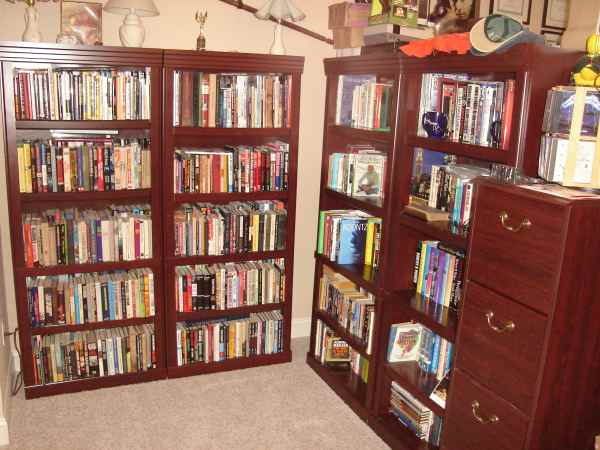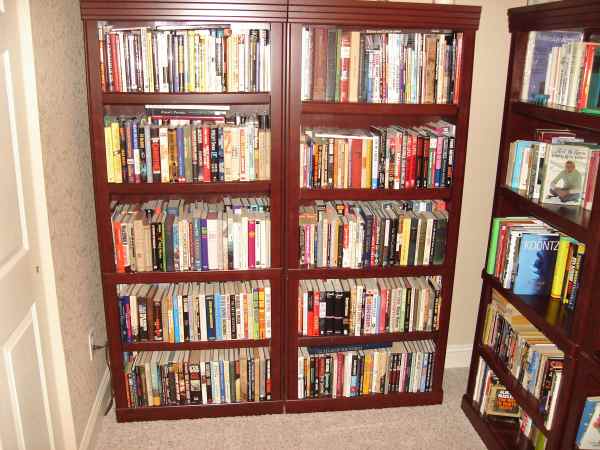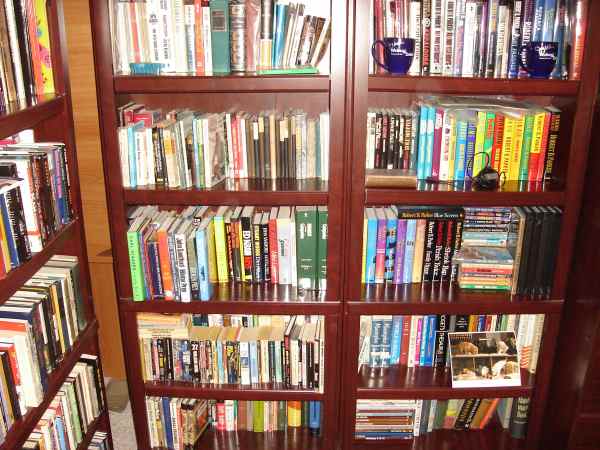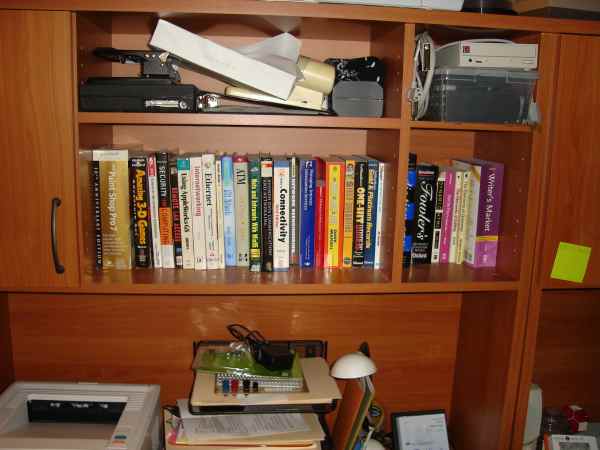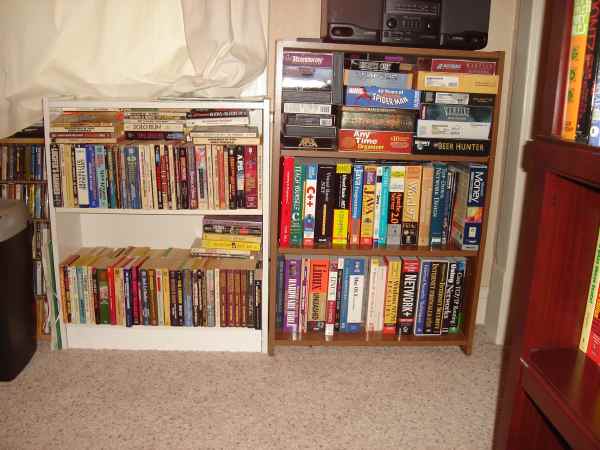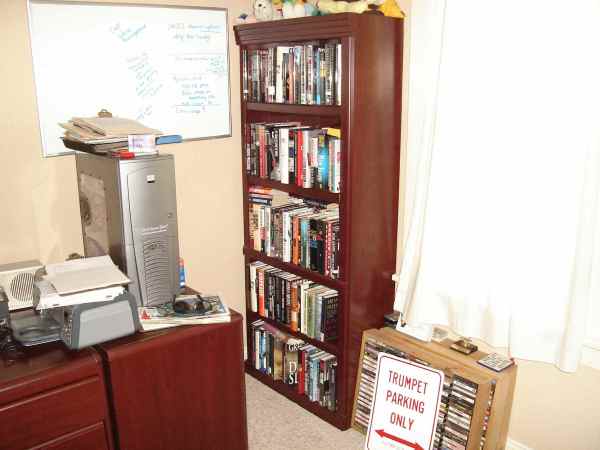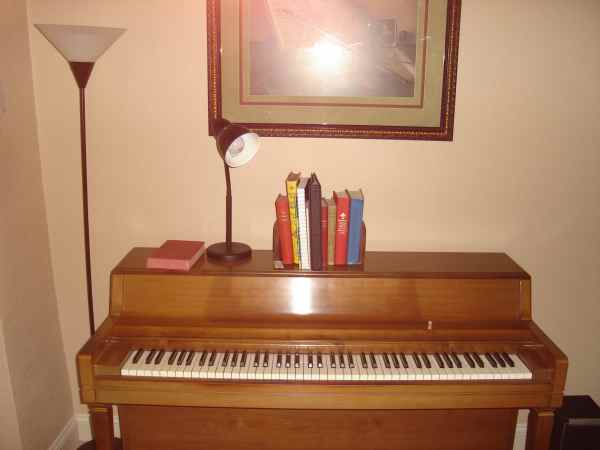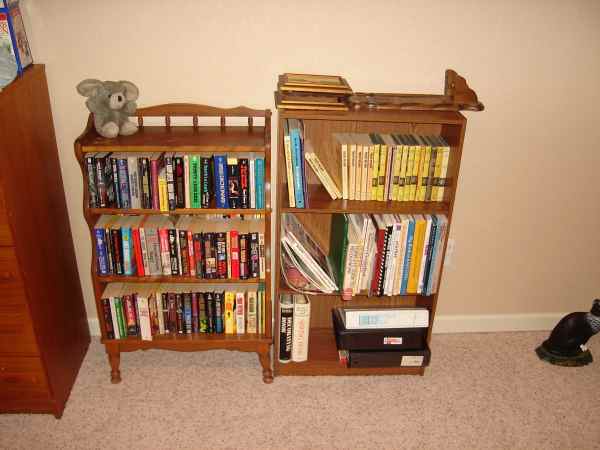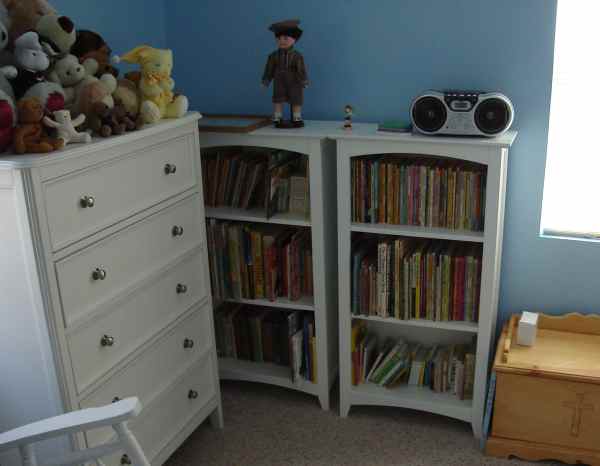Even though we’ve gone to a couple smaller book fairs this year, yesterday really marked the beginning of the book fair season for us, as we hit three smaller fairs around the metro area.
We started bright and early with the Immaculate Conception Church in Arnold. It was a bright, sunny day and our trip to the hinterlands (some would have said the hindquarterlands) of St. Louis County was uneventful, but that’s only because the brakes on a pickup truck traveling on state highway 141 smoked but held when the minivan in front of it stopped for the red light at Arnold Church Road. The area around Arnold and that formerly unpopulated space between Arnold and Fenton is filling in with lush housing developments. Across the street from Immaculate Conception, they’re building a new VFW; fortunately for that organization, the WWII and Korean War vets have a great potential of new member infusion these days.
We parked in the lot between the church and the parish center, avoiding politely the spaces marked Reserved for Funeral Parking. The book sale itself was on the lower level of the Parish Hall, through the byzantine and curious corridors of another church. The hardbacks were a dollar unless marked differently, and the paperbacks were fifty cents. I found a couple books, including an Evan Hunter novel from 1972, a volume of selected John Donne (to read to the boy in between Rod McKuen and the complete works of Emily Dickinson), the complete works of Keats and Shelley (ditto), and the autobiography of Golda Meir (because she was from Milwaukee). Cumulatively, my wife and I spent $9.50. As we left, I politely avoided the mourners standing in the parking lot as I drove aimlessly, or at least poorly-aimedly, looking for the parking lot exit.
We then shot up 141 to Chesterfield, an enclave of the better-to-do residents of St. Louis County. Our destination was St. John’s United Church of Christ, one of the few churches in the St. Louis area that I’ve actually gone into. A former girlfriend and her family attended church there, and although I never worshipped with them, I’d gone there some decade ago to pick something up with the ex. So I looked furtively about as we entered and throughout my shopping, watching for the mother or the ex, because nothing ruins a morning of book shopping like getting shot dead.
The selection was good, and the prices good, too; the same dollar for hardbacks and fifty cents for paperbacks. As we browsed, though, the workers for the group holding the book fair (Neighborhood Houses) added books to the tables or moved them around. One thing that peeves me off at these things is workers moving or adding books while I’m browsing; I’m always afraid that they’re adding just the thing I am looking for after I’ve looked or that they’re putting the books from the tables I’ve already browsed onto the tables that I’ve yet to see so that I’m looking through the same books twice.
I found a number of books here as well: a Classics Club entry to go into my collection, the only such book on the tables (although Heather told me later there was a whole box of them on the floor; at a buck each, I could easily have bought the lot and passed out the ones I already owned) and a couple of Time-Life books about repairing Major Appliances and Home Electronics (the cover depicts a turntable), among others. Together, we spent $10. I would have picked up Around the World in 99 Beds, a self-published book written by the wife of a seminary student or professor detailing their year on a sabbatical, travelling the world and visiting missions and former students. I would have paid fifty cents for it, but the book had been autographed on the title page by the author, and someone cut the autograph out, leaving only a couple whorls of an inscription. I mean, who cuts the autograph of an unknown local author from a book? Except a local forger, I mean?
This sale also featured a collectible book table at the front, where really old books had a price tag justified a listing from an Internet book sale site. Most of the books were just old, listed on the Internet for $10-20 and for sale for half that. Two browsers brought their own research to the sale; one had a book price reference guide and another used his cellular phone to check prices on the Web. This strikes me as gauche; I mean, spend the dollar and take a chance on it not being worth more than a dollar, you twits. That’s what I did when I was an amateur eBay book dealer, but that’s also why I ended up with a closet full of unsalable books for years.
Our final stop of the day was the Knights of Columbus Ladies Auxiliary book fair at the St. Catherine Laboure Parish Hall in South County. The ladies polled us on how we heard about the sale (Heather is a fan of BookSaleFinder.com). The selection inside was so-so, but we hit the jackpot on the prices again: still one dollar for hardback unless marked and fifty cent paperbacks. The sale also included a silent auction of various and sundry materials whose starting bid was justified by computer print-outs of the items listed at the same Internet book sale site that the previous book fair used. One might expect this site is the most expensive of all Internet book sites.
The people were friendly, offering to get me boxes to help me carry my pickings (No thanks, I replied; the more painful they are to carry, the fewer I will buy–this is what passes for self-discipline in my book fair shopping). Regardless, I bought: a picture book for Detroit’s resurgence, ca 1985 (Heather couldn’t believe I picked this up and might have thought the people behind the table were slipping random unsalable books into purchasers stacks, but I picked it up to provide a compare and contrast with the inspirational prose in the official line in Detroit 1985 and the panting about the resurgent St. Louis in 2007); a couple of movie tie-in paperbacks (Back to the Future and Rooster Cogburn) even though I passed up Outland at St. John’s–because it was the last book sale of the day, the justification for buying lowered measurably; Quality Management, a collection of columns from the magazine Quality published in 1980; a collection of Khalil Gibran poetry because someone quoted that poet to me in an IM conversation last week; and so on. Total spent: $13.50.
So by 11:30, we’d spent $32.00 and probably fifty miles of gasoline. Here’s our body count for the day:
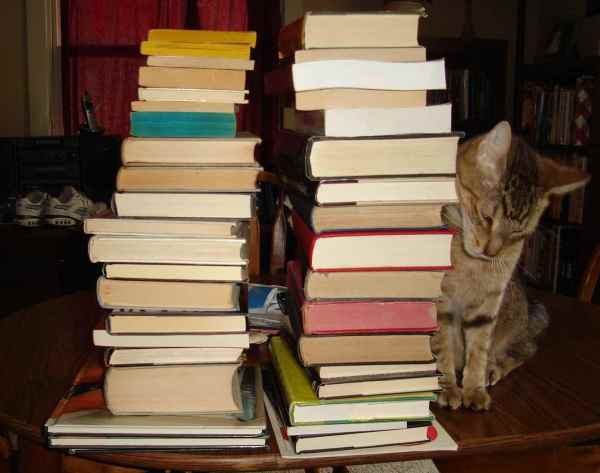
That looks to be 20 for me (left stack) and 18 for Heather (right stack), or a total of 38 for Ajax (who thinks they’re all for him, much like he thinks everything is for him). Heather’s stack includes 3 hymnals she’ll present as gifts and one book on cultivating tomatoes that has already shown up on my desk. 21 books, then, or 1 fewer than my total reading so far this year. One can easily understand how I continue to lose ground in my library building habits.



